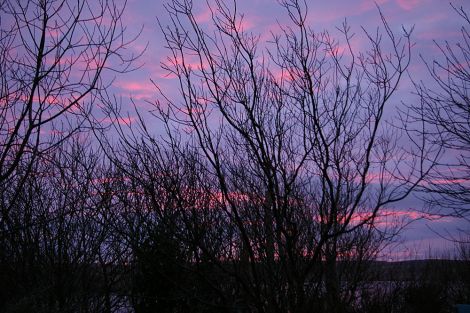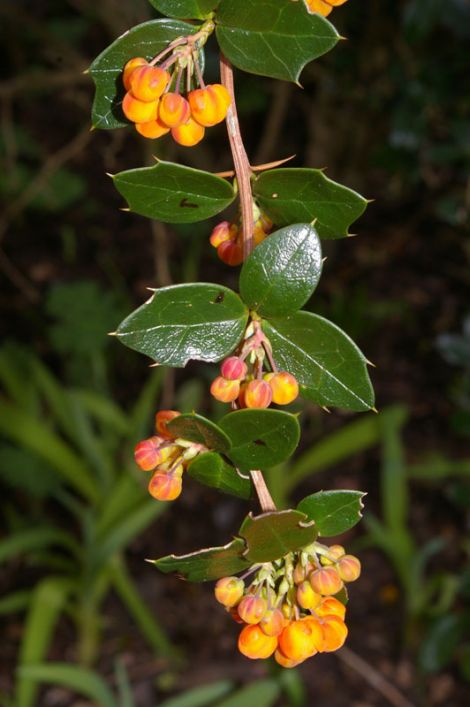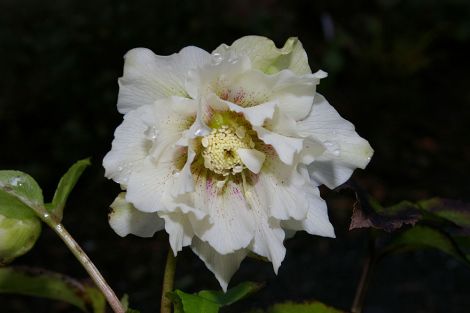Four Seasons / Four Seasons – Early Winter
Grey and brown, rather than white and blue have been winter’s predominant colours so far, and rather than the sound of snow crunching underfoot, there’s been the sucking noise of squelching through mud.
There’s nothing unusual about that in Shetland, but something quite extraordinary, something I’d never witnessed before, happened on 23 December, the third day of winter.
Feeding the birds is one of my great winter pleasures, and a task that gets me out into the garden on those days I’d much rather stay indoors. The day before Christmas Eve I headed out as usual, just after dusk, once all the starlings had returned to their roosts, with a large bowl of oiled porridge oats.
The blackbirds, 40 at the last count, usually wait eagerly, flit from branch to branch and start squabbling and screeching as soon as the first dollop of food hits the ground. Not this time. There wasn’t a single bird in the garden that day, nor the next, nor the day after that.
Three weeks after the Christmas Day hurricane a few have returned, but rather than congregating in the garden as is their long-established habit, they’re now widely spread across the croft and the shelter belts.
There was a lone starling, holding on to an elder twig for dear life on Christmas Day, before being blown right across the garden by the tempest.
A few small starling gatherings are now scraping a living off the sheep’s feeding blocks, but the great clouds that used to descend on the garden each and every day during the winter months have vanished.
It’s years since I’ve seen our pastures in such a poor state. The meadows always suffer when the hill sheep are in for tupping, and bare, brown, muddy patches around the feeding troughs are nothing unusual.
Become a supporter of Shetland News
But this year, all but the highest parts of the croft have become a mud bath. I’m sure the sheep, like me, would prefer frost and snow, but some crofters and those who have to commute on icy roads probably disagree with me.
Days between weathers are a blessing for the gardener at this time of year, especially when they end in one of those pink striped and dappled sunsets that throws the bare branches into stark relief and shows that the dormant buds are swelling at long last.
On such days, leisurely walks or tree-tie inspection rounds lead, more often than not, to a spot of impromptu gardening – the best form of gardening, to my mind.
Perennial weeds, such as those pesky tufts of coarse grass, well camouflaged in the crowns of border perennials during the growing season, now sit exposed and are easily dealt with, and little forests of bittercress seedlings hiding underneath dwarf shrubs, now devoid of leaves, can be skimmed off the soil surface with the edge of a sharp trowel in a trice – highly satisfying, but rather cold work.
A spot of winter pruning is perfect for reviving stiff fingers and warming cold toes. Deciduous trees and shrubs can theoretically be tackled at any time of year, but bare twigs and branches make it so much easier to see what needs removing or curtailing, and it doesn’t take long for the eye to discern what is last year’s growth and what is decades old.
Pruning is still a bit of a closed book for many gardeners, but is easily demystified if you follow one basic principle: always cut back to something – a branch, a twig, even a dormant leaf bud, and in the absence of all these, cut back to ground level. Never leave a stump. Stumps only ever do two things: They either sprout a forest of thin, watery shoots, or start to die back and rot, spreading fungal infections into healthy wood.
Every gardening book tells us that woody plants flowering before mid summer should be pruned after flowering. That is all very well, but in a large garden, during a busy season, such chores are often put off and eventually forgotten about.
I give all my shrubs a good going over every three or four years – in the dead of winter – by removing all dead wood, followed by cutting out about half of their oldest limbs. This means I sacrifice a few flowers in the forthcoming season, but end up with a rejuvenated plant that flowers all the more freely the following years, especially if the hard pruning is followed by a rich mulch of rotted manure or garden compost in spring.
In January a few dabs of colour can be found on winter’s drab palette. Bare soil has given way to fat, green shoots; snowdrops, crocus and winter-flowering iris are well above ground, showing slivers of promising colour, and the first hellebores are in full flower, regardless of the weather.
In my garden, more often than not, it’s the Lenten rose (Helleborus orientalis), that pips the Christmas rose (Helleborus niger) at the post. Its double forms are particularly precocious, expanding flowering stems as early as November some years. Buds expand during mild spells and the whole plant collapses spectacularly when frost hits, only to rise again, like Lazarus, as soon as a little warmth returns to the air.
Hellebore flowers are completely frost-proof, but those delicate petals of early flowering rhododendrons are not. Rhododendron ‘Snow Lady’ is a dwarf cultivar, wider than high, of a rather loose habit, but decked with hundreds of creamy-white saucers, provided the gardener covers the bush with a bit of sacking during those nights when the thermometer plummets.
Berberis ilicifolia needs no such precautions, and is, witch hazels aside, probably the most exciting winter-flowering shrub in my garden, evergreen into the bargain. The hard-textured, dark green leaves resemble those of a holly and its branches are hung with a myriad of tiny, bright orange baubles from late January onwards. It is easily raised from seed, but doesn’t take kindly to being confined in a pot. Once planted out, it makes rapid progress and can reach a height of two metres in a sheltered spot.
A mild, wet winter takes its toll amongst evergreens and alpines and makes life easy for pests and diseases, but it also has its little advantages. Fallen leaves break down into crumbly humus in no time, and my fish, usually dormant at the bottom of the pond, are cruising happily, if somewhat sluggishly, just below the surface.
Rosa Steppanova (www.leagardens.co.uk)
Become a supporter of Shetland News
Shetland News is asking its many readers to consider start paying for their dose of the latest local news delivered straight to their PC, tablet or mobile phone.
Journalism comes at a price and because that price is not being paid in today’s rapidly changing media world, most publishers - national and local - struggle financially despite very healthy audience figures.
Most online publishers have started charging for access to their websites, others have chosen a different route. Shetland News currently has over 600 supporters who are all making small voluntary financial contributions. All funds go towards covering our cost and improving the service further.
Your contribution will ensure Shetland News can: -
- Bring you the headlines as they happen;
- Stay editorially independent;
- Give a voice to the community;
- Grow site traffic further;
- Research and publish more in-depth news, including more Shetland Lives features.
If you appreciate what we do and feel strongly about impartial local journalism, then please become a supporter of Shetland News by either making a single payment or monthly subscription.
Support us from as little as £3 per month – it only takes a minute to sign up. Thank you.








